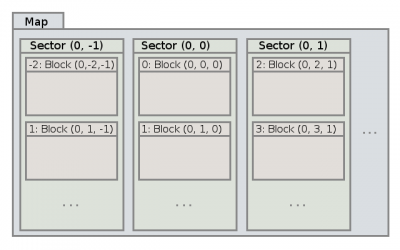Difference between revisions of "Engine/NMPR"
| Line 63: | Line 63: | ||
=== Environment === | === Environment === | ||
| − | The content of the environment is: | + | The content of the environment in NMPR is: |
* Map | * Map | ||
* List of Players | * List of Players | ||
| − | Players | + | Players contain: |
* Position and speed | * Position and speed | ||
* An Irrlicht scene node (that is rendered by Irrlicht) | * An Irrlicht scene node (that is rendered by Irrlicht) | ||
Revision as of 09:46, 20 January 2013
The base (NMPR)
Everything is built on a small core, that was the original network multiplayer release of Minetest (let's call it NMPR; the 2010-10-24 version). Being around 10000 lines of code, it contains:
- The Map: Voxel storage + lighting + rendering
- The Client + Server logic
- The Environment: Contains the map and the players, handles the simulation of the world
- The main loop: Invokes the client, the server, the environment and the rendering.
- A bunch of wrappers for OS-dependent things, and utilities.
As the current code still largely bases on the NMPR, it is useful to look at how it works.
Map (the voxels)
- The main content of the Map is a
map<v2s16, MapSector*>container. - The main content of a MapSector is
map<s16, MapBlock*>. - The main content of a MapBlock is a linear array of 16x16x16 MapNodes.
These form a relatively performant storage of voxel data. In addition to these containers, the latest fetched MapBlock is cached in each MapSector, and the last fetched MapSector is cached in Map, resulting in very useful sequential access speed through the whole abstraction layer.
Network protocol
The high-level network protocol of NMPR is delightfully simple. There are four commands for the server, and four commands for the client. Since this, a lot has been added and changed, but the basic idea stays the same.
Client -> Server
| TOSERVER_GETBLOCK | v3s16 p | Ask the server to send the data of a block |
| TOSERVER_ADDNODE | v3s16 p, MapNode node | Inform the server of a placed node |
| TOSERVER_REMOVENODE | v3s16 p, MapNode node | Inform the server of a removed node |
| TOSERVER_PLAYERPOS | v3s32 p*100, v3s32 speed*100 | Inform the server of the positon of the local player |
Server -> Client
| TOCLIENT_BLOCKDATA | v3s16 p, MapBlock data | Send the content of a block (16x16x16 nodes) |
| TOCLIENT_ADDNODE | v3s16 p, MapNode node | Add a node |
| TOCLIENT_REMOVENODE | v3s16 p, MapNode node | Remove a node |
| TOCLIENT_PLAYERPOS | foreach(player){
|
Update players on client |
Minetest uses it's own reliability layer on top of UDP. It isn't well documented at the moment, and thorough understanding of it isn't that important, so let's skip it as of now.
Environment
The content of the environment in NMPR is:
- Map
- List of Players
Players contain:
- Position and speed
- An Irrlicht scene node (that is rendered by Irrlicht)
- move() method with collision detection
Rendering
Rendering of players and UI is done by regular Irrlicht stuff (Irrlicht tutorials). What is interesting is how the voxel world is rendered.
In NMPR, rendering of the Map works like this:
Cache step (runs in the background, in a thread managed by Map)
- List MapBlocks in displayed area that have been modified
- Update lighting in them
- foreach(MapBlocks that were modified in the previous steps):
- Go through the MapBlock, detecting all air/non-air surfaces, collecting them to a list of faces
Render step
- Create a list of MapBlocks in rendering range
- foreach(MapBlocks in rendering range):
- If it is not in front of the player, skip it
- Draw the faces of the MapBlock
This is how Minetest works up to this day, except:
- At some point, instead of storing faces, Minetest was made to store meshes.
- In Minetest 0.3.1, occlusion culling was added to the render step
- In Minetest 0.4.3, the list of MapBlocks to be rendered is cached, and sorted by texture
